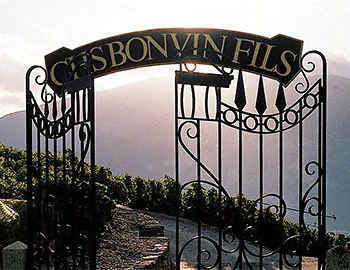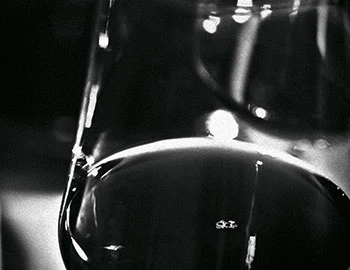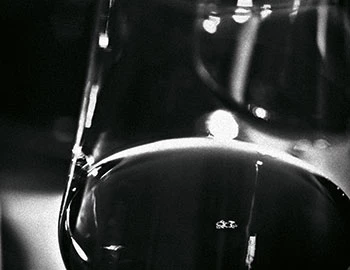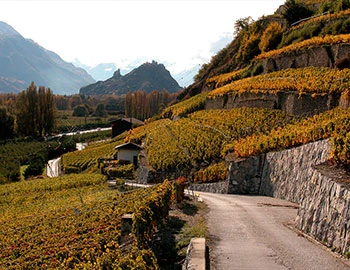Cuvée 1858 Rouge 2021
AOC Wallis, Bonvin, 750 ml

| Grape variety: | Cornalin, Syrah, Humagne rouge, Merlot |
| Producer: | Bonvin |
| Origin: | Switzerland / Wallis |
| Other vintages: |
Description
The noble Syrah and the rustic Cornalin enter into a fascinating marriage. This exceptional Cuvée was first presented for the 150th anniversary of Bonvin 1858 Les Domaines. The skilful ageing in oak is evident in aromas of cigar, coconut and frankincense. The multi-faceted aroma palette opens with notes of lilies, dried fruit and orange zest, rose pepper, eucalyptus, anise and mint, to name but a few. Finely polished tannins and a remarkable aromatic sustainability imbue the wine with finesse and elegance.
Attributes
| Origin: | Switzerland / Wallis |
| Grape variety: | Cornalin, Syrah, Humagne rouge, Merlot |
| Label: | Vegan |
| Ripening potential: | 2 to 10 years |
| Drinking temperature: | 16 to 18 °C |
| Food Pairing: | Châteaubriand, Filet Wellington, Roast saddle of venison, Saddle of lamb fillet with herb jus, Bistecca fiorentina, T-Bone steak, Hearty stew with pulses, Calf's kidneys with mustard sauce |
| Vinification: | short must fermentation, fermentation in wooden barrel, Punching down, soft pressing |
| Harvest: | hand-picking |
| Maturation: | long cultivation, in new barriques |
| Bottling: | no filtration |
| Maturation duration: | 18 months |
| Volume: | 13.5 % |
| Note: | Contains sulphites |
Bonvin
High above Sion, on the Clos du Château, is the heart of the oldest wine trading house in Valais – today's winery Charles Bonvin SA. The view sweeps over the wide Rhone valley, meets the two castle hills of Tourbillon and Valère and grazes on the magnificent Valais vine landscape with its countless terraces.
In the mid-19th century, Valais was a poor area. The valley was largely marshland. The people, mostly farmers, mainly subsisted from agriculture and the dairy industry. The wineries were set up where nothing else could be grown. The vineyard was smaller than the one in Zurich and the yield was mostly for self-consumption. The Valais wine couldn't leave its borders, although it had been cultivated since Roman times.

Humagne rouge
Wild wine
With this wine, you have a choice. Either drink it young, when its lush berry fruit dominates, or wait three to five years and experience its wild side. Even when young the Humagne rouge demonstrates echoes of tree bark and animal hide. These aromas truly come into their own with maturation. They are joined by hints of smoke, brushwood and pepper. The question of where it fits seems almost unnecessary: in the wild, of course. Its origins are confusing. The Humagne grape variety should have actually been called Cornalin. It is identical to the Cornalin from the Italian Aosta Valley. Another Valais grape – the Rouge du Pays – was erroneously named after this, which in turn operates mostly as Cornalin. Thus they are both falsely named.

Syrah
A hint of pepper
The legend stubbornly persists that the Syrah variety came from the Persian city of Shiraz. Yet, researchers have shown that it is a natural crossing of two old French varieties: the red Dureza from the Rhône Valley and the white Mondeuse blanche from Savoy. Wines from Syrah are gentle and concentrated. They smell of dark berries, violets and liquorice, and amaze with a piquant touch of white pepper. As varietal wines, they are found on the northern Rhone, as in the Hermitage or Côte Rôtie appellations, as well as in Swiss Valais. In the southern Rhône Valley, Syrah is often wedded with Grenache and Mourvèdre. In 1832, a Frenchman brought the variety to Australia, where it became the emblem of the national wine industry. There, the weightiest versions develop with typical notes of tar and chocolate.

Merlot
Everybody’s darling
Merlot is the most charming member of the Bordeaux family. It shines with rich colour, fragrant fullness, velvety tannins and sweet, plummy fruit. It even makes itself easy for the vintner, as it matures without issue in cool years as well. This is in contrast to the stricter Cabernet Sauvignon, which it complements as a blending partner. Its good qualities have made the Merlot famous worldwide. At over 100,000 hectares, it is the most-planted grape in France. It also covers large areas in California, Italy, Australia and recently in Eastern Europe. The only catch is that pure Merlot varieties rarely turn out well. Its charm is often associated with a lack of substance. Only the best specimens improve with maturity. They then develop complex notes of leather and truffles. This succeeds in the top wines from the Bordeaux appellation of Pomerol and those from Ticino, among others.

Cornalin
A mouthful of wine
The Cornalin is the victim of confusion. It is one of the oldest specialities of Valais. Traditionally, it was known there under the name Rouge du Pays, or “country red”. But, as there was already a variety bearing that name in the Aosta Valley, it was officially rechristened Cornalin. It was thought that this referred to the same grapes. Yet genetic analysis showed that the two, while related, are not identical. There are thus two completely different grapes with the name Cornalin. The Valais Cornalin – or the Rouge du Pays – is a merry, everyday wine. It tastes of black cherry, raspberry and violets and fills the palate with plenty of velvety tannins. A slightly spicy note, as of cinnamon or cloves, is typical. It tastes great with mature Valais cheese and ham from a mountain pig!

Wallis
Valais: Alpine wines with class
More than 20 varieties of grapes can yield wines in Valais that are full of character. A large number of them grow on spectacular, steep slopes. Sealed off by mighty chains of mountains, old plantings like Petite Arvine, Amigne and Cornalin have survived in Valais, and today they are highly sought-after by wine enthusiasts. The highest vineyards in Europe are also found in Valais: the Savignin vines (known here as “Heida”), rooted in the mountain community of Visperterminen.

Switzerland
Switzerland – A small country with enormous diversity
Switzerland is famous for its banks, watches, and cheese, but not necessarily for its wine. The Swiss didn't invent wine, but they have been extremely open and curious to it. Wine culture arrived in what is now modern Switzerland via several routes: from Marseilles to Lake Geneva and the Lower Valais region; from the Aosta Valley through the Great St. Bernard Pass to the rest of Valais; from the Rhone through Burgundy, across the Jura Mountains to Lake Constance; and from Lombardy to Ticino, and then on to Grisons.



